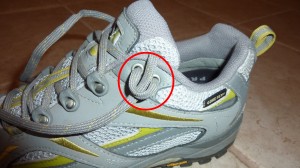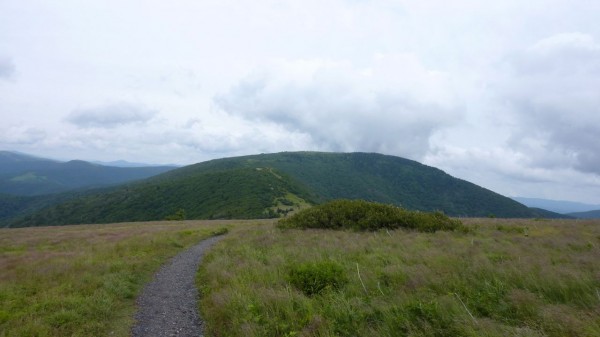Are you planning a hike in mountainous terrain or a gorge? Extended descents can put significant pressure on the knees and cause swollen toenails. Here are a few steps you can take pre-hike to minimize painful toenails, black toenails, and eventual toenail loss. We’ve already covered protecting your knees downhill in a previous article.
Lacing technique to secure your foot
Improper lacing can cause your foot to slide forward on steep descents, causing your toes to bang into the front toe box and bruise. The overhand lacing technique will help hold your foot securely toward the heel of your boot to prevent foot sliding. It acts as an anchor so that you can adjust the tension levels between your foot and ankle. This method also works if you have a narrow heel or your boots don’t fit quite right.
Downhill hiking shoe lacing technique –
- Boots: Tie locking overhand knots between the eyelets or lace hooks, beginning with the one in the middle of the instep (the first hook at the top of the foot, as opposed to the arch on the bottom). Continue to lace overhand knots to the top of the boot.
- Trail Shoes: Lower profile shoes don’t slip as boots do however, mid-height shoes (covering the ankle) may require the loop lacing technique in the upper eyelet to prevent slipping. The last eyelet of the shoe is usually a parallel set. Make a loop by threading the lace through both eyelets, bringing the lace underneath the loop. Repeat for the other side. Tie the shoes as usual. This last loop is crucial for preventing foot slippage, especially if you have a narrow foot or heel. Tightening in the loop provides improved tightening and stability.

Keep your laces tight!
The repetitive motion of hiking downhill will loosen up your laces, especially the rounded, synthetic laces which tend to slip. Make sure to periodically check the laces and tighten as needed during long downhill stretches—double tie your last knot to prevent laces from loosening.
Good arch support
The problem isn’t always caused by the toes bumping from improper fitting shoes or lacing technique. Sometimes it can be caused by a flattened insole. Insoles will eventually flatten from the weight of your body and pack, putting downward pressure on your arches. It will also make your shoes feel tight. Poor support will make your foot flatter inside the shoe and increase the volume, causing it to feel tight. Most hiking shoes and boots will have decent arch support when new. The insoles will eventually flatten from use and no longer hold your heel into place. Assuming you like how your shoe fits and still has good traction, try replacing the liner first (see below for suggested arch supports for backpacking).
Footwear designed for backpacking
Shoes marketed for light hiking or trail running are designed to be fast and lightweight, not for supporting extra pack weight; thus, these shoes often provide flimsy liners with poor arch support to save an ounce or so on the overall shoe weight. The poor liner should not be the deciding factor, as trail runners and cross trainers can be more comfortable for long-distance backpacking. Replacing the manufacturer’s insole with one that offers more support is a simple and inexpensive fix. Proper arch support is important because it helps maintain balance and reduces muscle strain.
- Look for insoles that offer a higher arch to hold your heel in place. There are many choices for aftermarket liners. Some popular options are Superfeet Green (superfeet.com, $37), Montrail Enduro Soles (montrail.com, $40), and heat-moldable Sole Signature Ed Viesturs (yoursole.com, $45).
- If you are out on the trail and your arch support has flattened (and you have a foam backrest or mat), cut a small corner from your foam pad and secure it with duct tape to the inside of your shoes where your arch makes contact. This will make your foot sit taller inside the shoe and allow for higher arch support.
Other helpful tips to prevent toenail loss
- Keep your toenails clipped short.
- When you add 30 pounds to your back, the weight will cause your arches to drop, and your feet sit longer in the shoe than without the added weight. When you purchase new hiking shoes, get ones that are 1/2 size larger to accommodate for the feet taking up more volume from the added weight, as well as for your foot swelling on long-distance hikes. And keep your pack weight as light as possible!
- If all else fails, stuff tissues into the toe part of the shoe to cushion the bang.
Black Toenails!
What causes your toenails to turn black while hiking? If you think of all the thousands of footsteps you take day after day, the accumulation of all that bumping and banging during downhills results in a bruised toe. Toenail bruising can be prevented using overhand lacing tightening when hiking downhill. If you do develop black toes, don’t worry. The black toenails will eventually fall off as the toenail continues to grow and pushes out the damaged nail. This process may take a few weeks or months, but it will get replaced with shiny, new pink ones.
If you are on the trail and develop a painful, swollen black toe, drain out the blood underneath the toe to release the pressure and give instant relief. Sterilize a needle with hot, boiling water or wipe thoroughly with an alcohol hand wipe. Try to access the blister underneath or around the toenail first — otherwise, you’ll have to scrape the needle into the toenail and create a small hole. Apply pressure to the blister and drain off the fluid. Smear with antibiotic cream and put a bandaid over the hole. You want to make sure it stays as sterile and clean as possible.

9 thoughts on “Saving your Toes Hiking Downhill”
I use the superfeet green and happy with the results
Thank You. This article is very helpful. Would you kindly recommend a few good hiking shoes?
So a question then, my left foot is half a size smaller than my right, so I usually size for my right foot. My fear though is that if I size to a 7.5 (my current boots are 7) then my left foot will feel like a clown shoe. As it is my right foot slides forward and hits the front of my shoe, but I can’t seem to get it to stay back.
Sorry to hear that! This makes proper fitting more difficult, although not impossible. You can first try Foot Petals to pad the interior of the larger shoe. If that doesn’t help, consider going to a podiatrist to get a custom orthotic toe filler made to pad the front toe box.
Got a blister on my toe and it looks really swollen. Is it better to just pop and drain or should I let it just go though it’s corse?
Keen women’s hiking shoe with boxed toes works great for me. Also, drain toe nail and keep clean & dry. Happened to me on an 11 mile hike my toe nail was too long NY and formed a blood blister under nail bed. That was two months ago and my toe nail just fell off this week . You can see the new fresh one right away.
My name is Sally and I am writing because I have plantar fasciitis. As a keen walker and hiker, I feared this would rob me of my most cherished hobby – along with walking the dog. However, after talking to physicians and experts, it turned out that walking might be the best solution to the problem.
As I happen to also be a freelance health and outdoors writer, I’ve teamed up with a small hiking site to develop a guide covering what plantar fasciitis is, and how walking affects it – and could be a solution to it. If you have an extra minute, you can check out the article here: http://backpackerverse.com/walking-with-plantar-fasciitis/.
I know you are busy, so I’ll keep this quick. Recently, I came across blog.outdoorherbivore.com and you reminded me of my article. Having read https://blog.outdoorherbivore.com/camp-tips/saving-your-toes-hiking-downhill/ I thought this would be something you’d like to mention. Of course, I am more than happy to write a brief introduction to the article to put on your website.
Please let me know what you think!
Best Regards,
Sally,
how do you do an overhand knot on shoes?
Yeaa, so how do you do the “overhand lacing technique”?